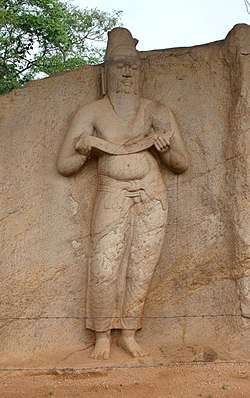Polonnaruwa period
The Polonnaruwa period was a period in the history of Sri Lanka from 1017, after the Chola conquest of Anuradhapura and when the center of administration was moved to Polonnaruwa, to the end of the Kingdom of Polonnaruwa in 1232.
| 1017–1232 | |
 | |
| Including |
|
|---|---|
| Preceded by | Anuradhapura period |
| Followed by | Transitional period |
| Monarch(s) |
|
Part of a series on the |
||||||||||||||||
|---|---|---|---|---|---|---|---|---|---|---|---|---|---|---|---|---|
| History of Sri Lanka | ||||||||||||||||
_-_Geographicus_-_Taprobane-mallet-1686.jpg) | ||||||||||||||||
| Chronicles | ||||||||||||||||
|
||||||||||||||||
| Periods | ||||||||||||||||
|
||||||||||||||||
| By Topic | ||||||||||||||||
|
| ||||||||||||||||
The Kingdom of Polonnaruwa was the second major Sinhalese kingdom of Sri Lanka. It lasted from 1055 under Vijayabahu I until 1212 under the rule of Lilavati. The Kingdom of Polonnaruwa came after the Anuradhapura Kingdom, which was invaded by Chola forces under Rajaraja I. It also followed the Kingdom of Ruhuna, in which the Sinhalese Kings ruled during Chola occupation.
Overview
Periodization of Sri Lanka history:
| Dates | Period | Period | Span (years) | Subperiod | Span (years) | Main government |
|---|---|---|---|---|---|---|
| 300,000 BP–~1000 BC | Prehistoric Sri Lanka | Stone Age | – | 300,000 | Unknown | |
| Bronze Age | – | |||||
| ~1000 BC–543 BC | Iron Age | – | 457 | |||
| 543 BC–437 BC | Ancient Sri Lanka | Pre Anuradhapura | – | 106 | Monarchy | |
| 437 BC–463 AD | Anuradhapura | 1454 | Early Anuradhapura | 900 | ||
| 463–691 | Middle Anuradhapura | 228 | ||||
| 691–1017 | Post-classical "Medieval" Sri Lanka |
Late Anuradhapura | 326 | |||
| 1017–1070 | Polonnaruwa | 215 | Chola conquest | 53 | ||
| 1055–1232 | 177 | |||||
| 1232–1521 | Transitional | 365 | 289 | |||
| 1521–1597 | Early Modern Sri Lanka | Crisis of the Sixteenth Century | 76 | |||
| 1597–1815 | Kandyan | – | 218 | |||
| 1815–1948 | Modern Sri Lanka | British Ceylon | – | 133 | Colonial Government | |
| 1948–1972 | Contemporary Sri Lanka | Sri Lanka since 1948 | 72 years ago | Dominion | 24 | Constitutional monarchy |
| 1972–Present | Republic | 48 years ago | Unitary semi-presidential constitutional republic |
Political history
Chola conquest (1017–1056)
The Chola conquest began with the invasion in 993 AD, when Raja Raja Chola sent a large Chola army which conquered the Anuradhapura Kingdom, in the north, and added it to the Chola Empire. Most of the island was subsequently conquered and incorporated as a province of the vast Chola empire during the reign of his son Rajendra Chola.[1][2][3][4]
Kingdom of Polonnaruwa (1056–1232)
Vijayabahu I (1055–1110), recaptured the whole Island and established Polonnaruwa as the new capital. King Vijayabahu married a second queen from the Kalinga (Orissa) Royal Family, and had a son, Vikramabâhu I, and a daughter, Ratnavali. His sister, Mitta, married a Pandya Prince who had three sons. His eldest son, Manabharana, married Ratnavali. Their son was Parākramabāhu I (1153–1186) Grandson of Vijayabahu I, Prince of Sinhalese-Pandyan-Kalinga descent, son of Manabharana and Vijayabahu's sister, Mitta. He was a very powerful king who was noted for his engineering,[5] naval power, art, culture, Sinhala inscriptions, and even a Tamil edict in Uruthota (Kayts). The Chulavamsa was written by Dharmakirthi, updating the Mahavamsa to include Parakramabahu.
See also
- Mahavamsa
- Architecture of ancient Sri Lanka
- Sinhala Kingdom
- List of Sinhalese monarchs
References
- Chattopadhyaya, pp 7–9
- Indian History with Objective Questions and Historical Maps Twenty-Sixth Edition 2010, South India page 59
- Hermann Kulke; K Kesavapany; Vijay Sakhuja (2009). Nagapattinam to Suvarnadwipa: Reflections on the Chola Naval Expeditions to Southeast Asia. Institute of Southeast Asian Studies. pp. 195–. ISBN 978-981-230-937-2.
- Charles A. Gunawardena (2005). Encyclopedia of Sri Lanka. Sterling Publishers Pvt. Ltd. pp. 71–. ISBN 978-1-932705-48-5.
- Broheir, R. L. (1937) Ancient Irrigation Works in Ceylon. 3 vols.